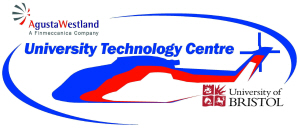AgustaWestland UTC
Lift-Off for the AgustaWestland UTC
Visitors to the Structures laboratory in BLADE will find a new ‘occupant’ in residence: they will not be able to miss the carcase of a Lynx Helicopter supported at Mezzanine level on a custom built frame! This newcomer symbolises the growing collaboration between the Engineering Faculty and AgustaWestland and is one of the many investments being made by both parties in the new AgustaWestland UTC (University Technology Centre) on Vibration Reduction.
For many years, the Engineering Faculty has had close links with Westland Helicopters (now, AgustaWestland) in both its teaching and research activities. One of the strong themes of the research collaboration has been focussed on the many vibration and structural dynamic problems which plague helicopters more than almost any other man-made structure. In most machines, vehicles and structures, vibration is an unwanted side effect of moving components which causes undesirable discomfort, noise, unreliability and - in more extreme cases - structural failure through fatigue. In the great majority of cases, it is a second-order effect, caused by slight out of balance, or non-smooth road surfaces etc. but in helicopters there is an in-built first-order dynamic loading which results from the inherent nonsymmetry of the large aerodynamic forces on the rotor blades. This is particularly acute when the helicopter is in forward flight as well as hovering. As a result, the levels of vibration in a helicopter tend to be much higher than those experienced in other vehicles: hence the strong interest in the structural dynamics expertise that can be found amongst the many research groups who are active in the BLADE laboratories.
This is the background to the creation of a strategic partnership between UoB and AgustaWestland which is modelled on the UTC format developed over the past 20 years to a very high degree of sophistication by Rolls-Royce (and whose Composites UTC is now another major initiative in the Aerospace Department ). An agreement to establish the AgustaWestland UTC in Vibration Reduction was formally signed in 2007 and over the past 2 years the structure, fabric, team of researchers and initial 5-year research programme for the Centre have all been assembled. Just a few weeks ago, at the end of September 2009, the first formal meeting of the UTC’s Steering Committee – with representatives from Bristol, Yeovil and Cascina Costa (AgustaWestland’s HQ in Italy) was held to review the first year’s technical progress and to chart the way forward for the next few years .
While the UTC is primarily concerned with the prosecution of a large research programme (there will be between 4 and 6 full-time researchers, most of whom are postdoctoral RAs), it is intended that - as a strategic partnership - there will be many more interactions between the university and the company than those dealing with the core research tasks. The UTC team will become involved in other technical activities at AW: for example, in September three of the UTC researchers participated in the vibration testing of a new helicopter – a major milestone in the development of any new aircraft and an event rarely observed by ‘outsiders’ to the company that builds it. Also, there will be many points of contact between AgustaWestland and the UG and PG course activities – final-year or design projects, industrial visits – even, in the next few weeks, the opportunity to experience a flight in a helicopter - although not the one which will soon reside in the BLADE laboratories!
For further information on the UTC please see the AgustaWestland web site

